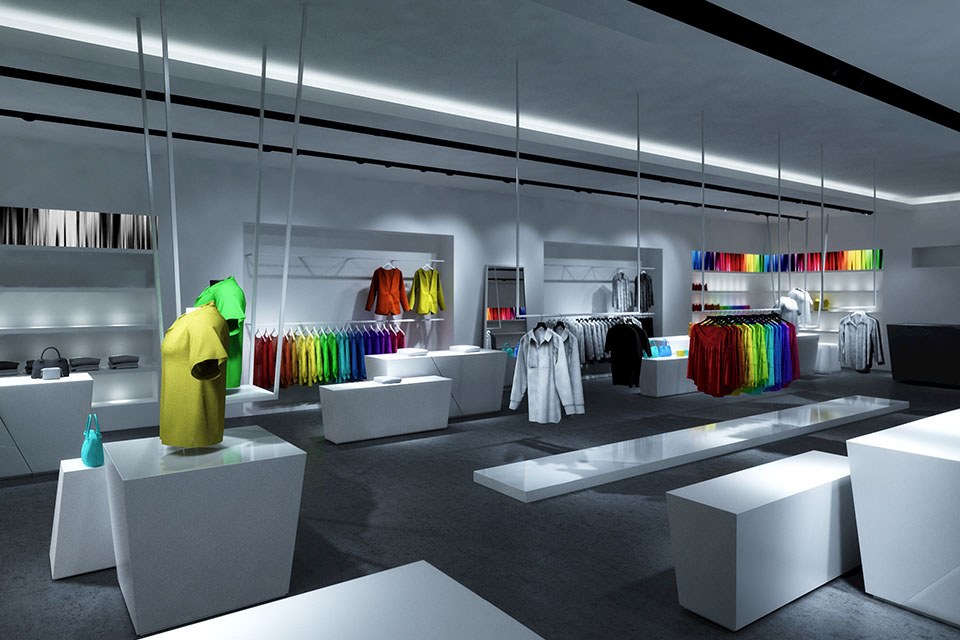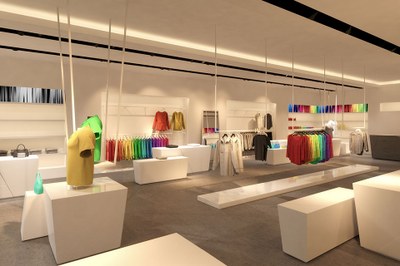Target Group-Adequate Lighting of Shop and Retail Areas – New Retail Study by Zumtobel
n a laboratory study conducted by Zumtobel and Gruppe Nymphenburg it has been possi-ble for the first time to measure people's affective responses to various lighting scenarios in shops on an empirical basis. In the process, the lighting preferences of seven different groups of customers were analysed using a neuropsychological target group model. The findings of this study will help to develop lighting concepts for retail, to present goods per-fectly and to increase the customers' sense of well-being, thus making them stay in the shop longer.
The most recent research in the area of neurosciences has shown that more than 80 % of buying decisions at the point of sale (POS) are made unconsciously, mainly depending on influences addressing people's emotions. Perfect lighting plays a major role in this context: customers do not only perceive the goods visually, but will be touched by an attractive lighting scenario at the emotional level. However, the effects of light have so far been evaluated only by means of various questioning techniques, without taking the decisive aspect of the uncon-scious into account. For that reason, Zumtobel Research jointly with Gruppe Nymphenburg, a Mu-nich-based consultancy and market research institute, initiated a laboratory study in order make the emotional effects of light on customers measurable empirically, recording their physiological responses. “Light has a major unconscious impact on people”, explains Dr. Hans-Georg Häusel of Gruppe Nymphenburg. “Therefore, those who wish to collect data that can be empirically meas-ured and also challenged have to deal with the unconscious, carrying out measurements at the place where people's emotional responses originate.”
The “Limbic Model”: characterisation by personalities
For the laboratory study, the researchers used the “Limbic Model” developed by Gruppe Nympen-burg, which focuses on the complex emotional personality structures of consumers. The sociode-mographic data of the 48 subjects involved where therefore negligible for the purpose of the study. Instead, the subjects were assigned to seven different personality types, the “Limbic Types”, using a questionnaire. These included the “Bon vivants”, the “Hedonists”, the “Adventurers”, the “Per-formers”, the “Disciplinarians”, the “Traditionalists”, and the “Harmonisers”. The objective of the research project was to find out how these seven groups respond to various lighting scenarios at the POS. For this purpose, a new method developed by Gruppe Nymphenburg was used, the “Limbic Emotional Assessment” (LEA). Using this method, even the most minor physical responses can be measured.
In the laboratory experiment, the researchers placed the male and female subjects between 19 and 62 years of age in front of a 3D shop simulation installed in a research lab, which displayed fashion items illuminated in various different ways. The subjects successively looked at 20 different lighting scenarios with various ambient and accent lighting features, colour temperatures, contrasts and light quantities. While doing so, their unconscious physical reactions, including brain waves and cardiac activity, were empirically measured. Based on the psychophysiological data collected, it was possible to clearly establish which of the lighting scenarios' parameters triggered positive or negative emotions, stimulation or relaxation in specific target groups. In the process, it was found that even minor changes between the individual lighting scenarios triggered different responses in the subjects.
On the results [1]
The findings obtained clearly show that there is an optimal way to address each individual target group. It has also turned out that there is no single lighting scenario which has the same markedly positive impact on all “Limbic Types”. There are, however, individual lighting profiles which several types respond positively to. Three main groups were identified, each with similar requirements as to lighting solutions: the first group, BALANCE (Harmonisers, Traditionalists and Bon vivants), re-sponded particularly positively to moderate accent lighting. The second group, STIMULANCE (He-donists, Adventurers), responded most positively to lighting scenes with relatively strong contrasts, created by accent lighting and a variety of different spots. Group three, DOMINANCE (Performers, Disciplinarians), responded sensitively to unbalanced lighting concepts and can best be loaded with positive emotions through balanced, moderate effects. However, narrow-beam lighting with extreme contrasts triggered negative emotions in this group.
Dr. Hans-Georg Häusel summarises: “Again and again we find that the importance of lighting at the POS is dramatically underestimated. Instead, the focus is on fancy packaging and shop design. But actually, the goods on display will only touch people's emotions if they are set centre-stage through light. Even the affective signals emanated by the shop itself are strongly influenced by light.”
For only if customers feel at ease inside a shop and perceive the lighting scene as attractive will they be motivated to stay for a while. Ultimately, this means that customers will have more time to notice the products and brands in a shop and to buy them. “By combining neuromarketing with our lighting expertise, we can effectively implement a new way of addressing our target groups already at the stage of lighting design, for the benefit of our customers”, says Peter Kovacs of Zumtobel. “This helps us create lighting scenarios for specific brands and target groups that accurately meet the needs of customers in shops and retail areas.”
[1] Abstract. For more information on the retail study and the detailed results, please refer to the Zumtobel White Paper “Limbic Lighting – target group-adequate lighting of Shop & Retail areas”.
On the research method:
The Limbic Emotional Assessment (LEA) research method, which has been developed by Gruppe Nymphenburg, is based on methods used in neurosciences as well as psychophysiology. The latter discipline is concerned with the relationship between brain activity and the related physical responses. In combination with Limbic, a brand and target group navigation model tried and tested in practical applications, LEA allows for a distinction according to specific target groups. In doing so, the scientifically tested LEA method combines five different parameters that capture even the tiniest of physical reactions. From brain waves and skin conductance through to cardiac activity, numerous physical reactions of customers are meas-ured to draw conclusions on their emotional state.
Gruppe Nymphenburg:
For more than 40 years, Gruppe Nymphenburg as a consultancy and market research company has supported leading manufacturers of branded products and trading companies in areas ranging from brand positioning through to POS imple-mentation. Their consultancy is based on in-depth knowledge about the behaviour of consumers and shoppers. Gruppe Nymphenburg count themselves among the world's leading experts in neuromarketing. In addition, the company specialises in psychological POS and shopper research.




